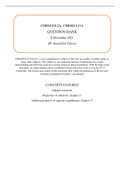CHEM1012A, CHEM1013A
QUESTION BANK
8 December 2021
BY Amatullah Chiosa
CHEM1012A/1013A is a very comprehensive subject if the tools are readily available unlike so
many other subjects. This subject is very important because it determines how much
understanding and effort has gone into solving relatively difficult problems. With the help of this
document, an understanding can be established which will assist in the test on the 8th of
December. The format and content of this document falls within the guidelines of the test and
will help you prepare for paper 1 accordingly.
CONCEPTS COVERED
Organic reactions
Properties of solutions: chapter 13
Additional aspects of aqueous equilibrium: chapter 17
,This document includes:
➢ 40 multiple choice questions
➢ Full explanation for each question
Test strategies for multiple choice questions
➢ Answer easy questions first
➢ Hide the options, read the stem, and try to answer
➢ Treat each option as a true-false question and choose the “most true”.
➢ Always guess when there is no penalty
➢ Practice as much as possible before the test
➢ Take a guess when you’re stuck, never leave a question unanswered
➢ One helping strategy for learning the key chemistry concepts that will show up on the test
is to make association between terms and concepts.
➢ In certain questions on the exam, the test writers ill obscure the information in the
question to make it harder to read. Its simple, really. Just take a deep breathe. And
rephrase the question
➢ Most questions require you to use the process of elimination. This is the most important
strategy because it invokes deciding what the bad answers are and crossing them off,
instead of just looking for the right answer.
, Multiple choice questions
1. The carbon-carbon bond lengths in rank of increasing bond length is:
A. Triple, double, single
B. Single, double, triple
C. Single, triple, double
D. Triple, single, double
2. Which of the following is NOT an electrophile?
A. NH3
B. Br+
C. AlCl3
D. NO2+
3. Homolytic fission of C-C bond leads to the formation of:
A. Carbonium ions
B. Free radicals
C. Carbanions
D. None of these
4. The solubility of oxygen gas in water at 250C and 1.0 atm pressure of oxygen is
0.041g/L. The solubility of oxygen in water at 3.0 atm and 250C is __________g/L.
A. 0.041
B. 0.014
C. 0.31
D. 0.12
E. 2.0
5. Which of the following classes of compounds is unreactive towards sulfuric acid?
A. Alkanes
B. Alcohols
C. Alkenes
D. alkynes
6. the chlorination of methane to give CCl4 is an example of:
A. an electrophilic addition
B. a free-radical substitution
C. a nucleophilic addition
D. an electrophilic substitution
7. the pH of a solution that contains 0.818 M acetic acid (Ka=1.76x10-5 ) and 0.172 M
sodium acetate is ______________.
A. 4.08
B. 5.43
C. 8.57
D. 8.37
E. 9.92




